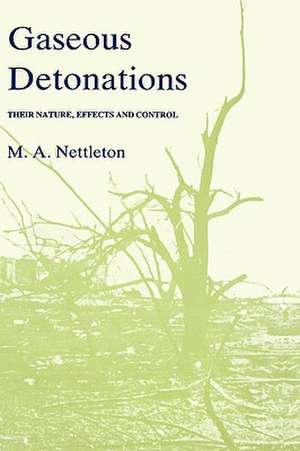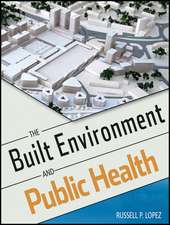Gaseous Detonations: Their nature, effects and control
Autor M.A. Nettletonen Limba Engleză Hardback – 31 ian 1987
| Toate formatele și edițiile | Preț | Express |
|---|---|---|
| Paperback (1) | 1092.99 lei 6-8 săpt. | |
| SPRINGER NETHERLANDS – 26 sep 2011 | 1092.99 lei 6-8 săpt. | |
| Hardback (1) | 1415.37 lei 6-8 săpt. | |
| SPRINGER NETHERLANDS – 31 ian 1987 | 1415.37 lei 6-8 săpt. |
Preț: 1415.37 lei
Preț vechi: 1489.87 lei
-5% Nou
Puncte Express: 2123
Preț estimativ în valută:
270.82€ • 282.77$ • 224.15£
270.82€ • 282.77$ • 224.15£
Carte tipărită la comandă
Livrare economică 04-18 aprilie
Preluare comenzi: 021 569.72.76
Specificații
ISBN-13: 9780412270406
ISBN-10: 0412270404
Pagini: 256
Ilustrații: XIV, 256 p.
Dimensiuni: 155 x 235 x 16 mm
Greutate: 0.56 kg
Ediția:1987
Editura: SPRINGER NETHERLANDS
Colecția Springer
Locul publicării:Dordrecht, Netherlands
ISBN-10: 0412270404
Pagini: 256
Ilustrații: XIV, 256 p.
Dimensiuni: 155 x 235 x 16 mm
Greutate: 0.56 kg
Ediția:1987
Editura: SPRINGER NETHERLANDS
Colecția Springer
Locul publicării:Dordrecht, Netherlands
Public țintă
ResearchCuprins
1 Introduction.- 1.1 General remarks.- 1.2 Definitions of commonly-used terms.- 1.3 Unidimensional models of detonations.- 1.4 Structure of a detonation wave.- 1.5 Philosophy of presentation.- 2 Unidimensional models.- 2.1 Introductory remarks.- 2.2 Properties of unidimensional shock waves.- 2.3 Properties of unidimensional shock waves with energy addition.- 2.4 Properties of the Chapman-Jouguet state.- 2.5 Comparison of C–J predictions and experiment.- 2.6 The Zel’dovich, von Neumann, Doring model.- 2.7 Comparison of the ZND model and experiment.- 2.8 The Taylor expansion wave.- 2.9 Concluding remarks.- 3 Structure of detonation fronts.- 3.1 General remarks.- 3.2 ‘Spinning’ detonation fronts.- 3.3 ‘Galloping’ fronts.- 3.4 Experimental studies of multi-headed fronts.- 3.5 Theoretical treatments of multi-headed fronts.- 3.6 Concluding remarks.- 4 Detonable media.- 4.1 General remarks.- 4.2 Confined and unconfined detonations.- 4.3 Gases and vapours which are detonable in the absence of an oxidant.- 4.4 Comparison of detonation limits for confined and unconfined detonations with flammability limits for mixtures of hydrocarbons with oxygen and air.- 4.5 Homology hypothesis for predicting detonation limits.- 4.6 Detonations with oxidants other than oxygen.- 4.7 Influence of initial pressure and temperature on detonability.- 4.8 Influence of additives on detonability.- 4.9 Detonations in suspensions of dusts and droplet mists in oxidizing atmospheres.- 5 Initiation of a detonation wave.- 5.1 General remarks.- 5.2 Initiation of confined detonations by shock waves.- 5.3 Initiation by blast waves from electrical and laser sparks and charges of conventional explosives.- 5.4 Detonations in large unconfined clouds of vapour.- 5.5 Minimum ignition energies.- 5.6 Laminarburning velocities.- 5.7 Expansion ratios.- 5.8 Detonations arising from accelerating flames.- 5.9 Influence of initial temperature and pressure of the medium on run-up distances.- 5.10 Influence of diameter of pipeline on run-up distances.- 5.11 Effect of additives on pre-detonation distances.- 5.12 Effects of surface roughness and obstacles on the acceleration of confined flames.- 5.13 Pressure piling (cascading).- 5.14 Concluding remarks.- 6 Interaction of a detonation with confinement.- 6.1 Introductory remarks.- 6.2 Diffraction at an isolated wall, ?w < 0°.- 6.3 Diffraction at an isolated wall, 0° < ?w < ?crit.- 6.4 Diffraction at an isolated wall, ?crit < ?w < 90°; standard two- and three-shock theory for non-reactive media and the effects of reaction.- 6.5 Normal reflection of a detonation wave.- 6.6 Transmission of a planar detonation wave through an abrupt expansion in area.- 6.7 Propagation of detonations through bends and junctions.- 6.8 Interaction of a detonation with an inert surrounding gas.- 6.9 Refraction of detonations in mixtures of different composition.- 6.10 Concluding remarks.- 7 Damage caused by detonations.- 7.1 Introduction.- 7.2 Early experiments on effective pressures generated by detonations.- 7.3 Damage produced by detonations in chemical plant.- 7.4 Experimental studies of failure resulting from detonations.- 7.5 Concluding remarks.- 8 Prevention and mitigation of detonations.- 8.1 Introductory remarks.- 8.2 Inhibition of flames of normal burning velocity.- 8.3 Venting in the early stages of an explosion.- 8.4 Quenching of flame-shock complexes.- 8.5 Suppression of detonations.- 8.6 Mitigating the effects of detonations.- 8.7 Concluding remarks.- 9 Concluding recommendations.- 9.1 Introductory remarks.- 9.2 Stress waves inconfining walls.- 9.3 Planned deformations as safety measures.- 9.4 Designing to minimize the effects of local peaks in pressure.- 9.5 Suggestions for further studies of detonations.- References.- Author index.










